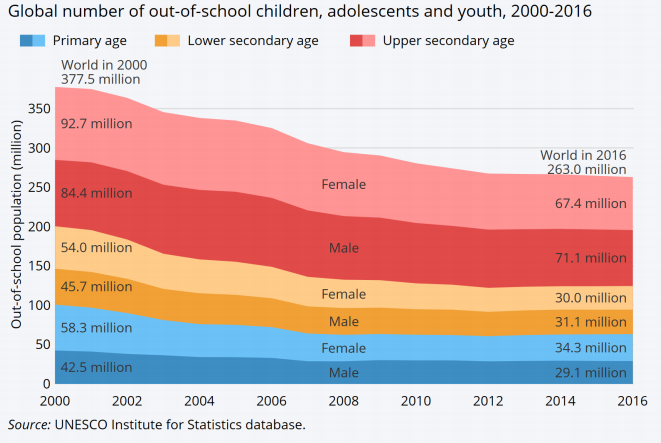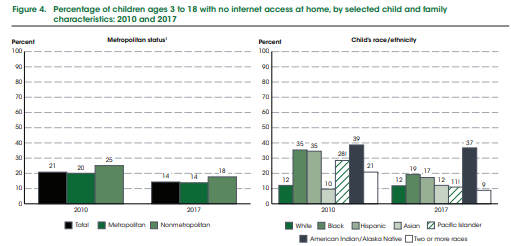The state of the educational system in the modern world is extremely contradictory. At one level, education became one of the most influential spheres in people’s lives, and the number of people who received education is much bigger than in earlier history of humanity. Scientific achievements have become the starting point for many social transformations and scientific and technological progress.
On the other level, the demand for educational services and the high prestige of education as a social institution are accompanied by an increasing number of problems. Some issues are still relevant for many countries: the elimination of illiteracy, the shortage of qualified teachers, the backwardness of educational technologies, the crisis of efficiency and productivity of the educational system. Thus, despite the record number of educated people, the problem of lack of education is more pressing than ever.
Description of the Problem
In 1869, in his outstanding essay “The New Education,” president of Harvard University Charles Eliot outlined general areas and ways for the education system development. In this essay, Eliot presented strong arguments for the constant renewal of the curriculum and teaching methodology so that learning could keep pace with the development of society. After one and a half hundred years, this approach is still relevant.
Lack of education is the inability of people to acquire specialized skills, such as cognitive skills, socialization, memorization of facts which are necessary for personal development and the development of society and the world economy. It can be manifested in inaccessibility to education for some parts of the population, for such reasons as the lack of schools, teachers, or money to pay for education. It also can be expressed as the education quality of citizens.
Often the inefficiency of the educational process organization has bad result – after several years spent in the educational institution, people cannot find a job as their knowledge and skills are not enough. Lack of education is a social problem, as education should promote humane and productive human life (Costache, 2018). In addition, well-educated people benefit society and continue its development.
Because of the technological development, jobs and competencies change faster than people can adapt. The major part of the world’s population is behind in the most important practical skills. In the nearest future, the major part of jobs will be connected with the IT-sphere. By anticipating changes of this magnitude, companies are urgently trying to find and gain the competencies needed to maintain competitiveness. Skills shortages are now one of the major threats to businesses.
This problem is of global scale and affects all areas of the economy. For example, according to Farooq et al. (2018), the successful economic development of Pakistan requires cooperation with China within the framework of China – Pakistan Economic Corridor (CPEC). However, researchers note a lack of qualified personnel, in particular women, in such areas as higher education and logistics for sufficient fruitful cooperation. The most vulnerable area in which education shortages are unacceptable is health care. However, even this sphere suffers from the problem of unskilled personnel. Coughlin (2017), for example, notes that nurses have not been professional enough for performing their job recently. She explores the field of nursing with Down Syndrome but it can be argued that it applies to all areas of medicine.
Information on the lack of education worldwide, as well as in specific countries, is confirmed by statistics from official sources of international organizations and government think tanks. According to UNESCO Institute for Statistics (2018), for example, one in five children of school age do not attend educational institutions, and the total number of such children in 2016 was more than 260 million. The statistics show that the number of out-of-school children decreased by 114,5 million. Moreover, the gender gap has declined – previously the number of girls not attending school has exceeded the number of boys. It is a reliable source, as this agency has sufficient influence in the world and is entirely independent.

Through statistics, significant gaps in the existing education system can be identified. For example, there is still a serious gap between the life quality in developed and developing countries, which also affects the education level. The publications of Our World in Data, whose research power is located at Oxford University, among many infographics, have also determined literacy rates in world states (Roser & Ortiz-Ospina, 2020). The downside of the provided statistics is that researchers failed to obtain data for several countries. However, these are only a couple of countries with small populations. According to the data, 142 world states have a high level of education of 90-100%, with 8 states having a 100% rate. In just over 20 countries, the literacy rate is below 60%. They found that most African countries had a literacy rate below 30 percent.

A Solution of the Problem
To improve the quality and accessibility of education, the modern system must change approaches to methodology in the realities of a contemporary world in which technology rules. Thanks to computers, phones and Internet, students of any age, nationality, and wealth will be able to access world knowledge. The process starts with the introduction of tiered online training, providing flexibility and financial availability.
Innovative technologies can significantly affect the field of higher education. For example, universities can offer students a short program of specialty before he or she is fully engaged in studies. It is a way how disappointments in the chosen area can be avoided. Various tools and opportunities, for example, mobile applications, will allow studying from any place of the world (Camilleri & Camilleri, 2017). It will also favor faster and easier adaptation when students are starting studies after a long break.
Solving the lack of education problem is a common issue. Universities play a significant role in changes and possible reforms. They can organize effective collaboration, followed by the creation of a specific system within which they will share experiences, courses, and questions (Burbules, 2018). The lack of qualified teachers can also be addressed through the availability of technology. After all, within the system, educational institutions can apply to various specialists, not only to theorists but also to practitioners, for help to organize remote education with interested students.
The shortage of personnel around the world is growing, and educational institutions and employers around the world must become partners. Such partnerships between universities and employers aim to ensure that students acquire skills useful in employment. The educational institutions should develop along with labor market and employers’ demands, and the situation is such that education is of unprecedented importance.
Universities must assign qualifications appropriate to the interests of employers. Moreover, employers today are increasingly interested in skills rather than traditional degrees. Higher education institutions should make it easier for students to acquire new skills. Education should not be pumped after graduation – universities should offer students advanced training programs to continue their graduate careers. After all, today, more and more people understand that lifelong learning is the only way to develop. Moreover, technology will be a useful link in these processes.
Ethical Consequences of the Proposed Solution
The introduction of innovative technologies in the educational process affects not only organizational, methodological, or technological aspects but also the value sphere. In a new electronic environment, learning loses its former character. In current conditions, society is increasing demands for personal communicative and professional competences of high qualification specialists. In this case, the loss of influence of the educational institute on the formation of moral qualities of the person can have far-reaching consequences.
The positive ethical consequence that should be noted is education availability. People from different places can reach professors in England or America with one click. A few problems can be allocated from this consequence. The positive one is that in a critical situation, the educational process does not stop. A fresh and bright example is the coordinated work of schools, universities, teachers, and students in the context of the spread of the COVID-19 pandemic in European countries.
Another critical problem is opportunities for self-organization and self-development. New technologies actualize the development of the student’s personal qualities, such as responsibility, autonomy, commitment, initiative. However, a large percentage of those who start studying remotely do not graduate because they have little skill and motivation to learn on their own. The consumer attitude of many students to studying leads to the transfer of responsibility for the process and result of training to the teacher and university.
Experts note that only about a third of students show personal activity in the educational process, most are motivated not to teach independently, but to receive ready information through the teacher. In addition, students’ use of the Internet primarily for public communication and entertainment, rather than as a tool for acquiring knowledge, makes additional problems.
The negative consequence of the introduction the innovative technologies into the educational system is their cost. At first, a large amount of money will be needed to buy the equipment itself. After that, it is a constant expense to maintain the right work, which requires both the attention of specialists and regular expensive updates. It also gives rise to several ethical problems. First, thus education is still not available to all. For example, according to McFarland et al. (2019), not even all children in America have internet access. In addition, the data also vary according to race and metropolitan status:

In 2017, the total percentage of children without home internet was 14. At the same time, the amount of students of nonmetropolitan status is larger than the metropolitan. Data, according to race, show that the most significant percentage of children without Internet access is American Indians and Alaska residents. Further, Afro-Americans and Hispanics are the largest percentages.
While the use of new technologies, and especially the Internet, is intended to make education more accessible, this can only highlight another ethical problem – the gap between rich and poor. This gap creates conflict and crisis situations. It suggests that the struggle of the poorest and middle class for their rights, for a fairer distribution of income, in different forms, will gain strength.
Conclusion
Thus, the number of educated people in the world is steadily increasing, but due to the rapid pace of development of the modern world, the level of education cannot sufficiently meet the demands of society. Schools should teach to think in accordance with the principles of contemporary science and the information and technological realities of modern society. Today, the task of finding a systemic solution designed to create a long-term interaction that will ensure the satisfaction of educational needs and the constant flow of trained personnel into all spheres of industrial relations.
References
Burbules, N. (2018). Watch IT: The risks and promises of information technologies for education. Routledge.
Camilleri, M. A., & Camilleri, A. C. (2017). Digital learning resources and ubiquitous technologies in education. Technology, Knowledge and Learning, 22(1), 65-82.
Costache, G. (2018). Lack of education, the main factor in committing anti-social behaviours. Journal of Law and Public Administration, 4(7), 34-37.
Coughlin, S. (2017). Nurses lack education in caring for patients with down syndrome. The Grace Peterson Nursing Research Colloquium, 24. Web.
Farooq, S., Gul, S., & Khan, M. Z. (2018). Role of trained women workforce in China-Pakistan economic corridor (CPEC): A gender gap analysis. Putaj Humanities & Social Sciences, 25(1).
McFarland, J., Hussar, B., Zhang, J., Wang, X., Wang, K., Hein, S., Diliberti, M., Forrest Cataldi, E., Bullock Mann, F., & Barmer, A. (2019). The condition of education 2019(NCES 2019-144). U.S. Department of Education. National Center for Education Statistics. Web.
Roser, M.,& Ortiz-Ospina, E. (2020). Global education. Our World in Data. Web.
UNESCO Institute for Statistics (UIS) (2018). One in five children, adolescents and youth is out of school. UIS fact sheet No. 48. Web.
